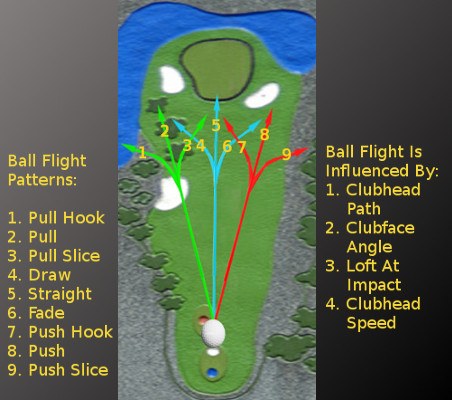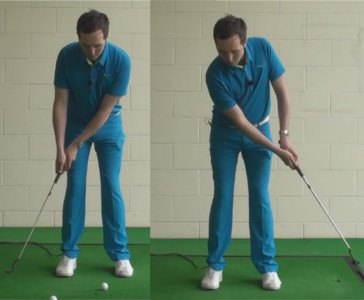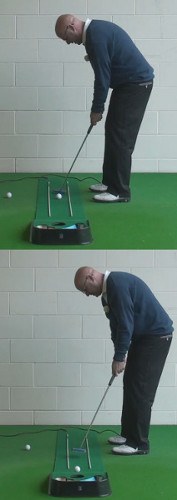
Every avid golfer knows that excess sidespin causes drives and approach shots to curve off line. But did you know that sidespin can wreck your putting, too?
The cause of sidespin is the same regardless of the club you're using. I happens when the face angle does not match the clubhead's path at impact. Here's a quick guide to the effects of different face/path combinations: What Makes the Golf Ball Curve?
While the effects of left-to-right (slice) or right-to-left (hook) spin are far less obvious on putts than on regular golf shots, the margin of error is also much smaller on the greens. Sidespin can cause a straight putt to veer off line, but it's especially harmful on breaking putts. For example, if you apply slice spin on a putt that breaks left-to-right, you'll almost certainly miss to the right. If you hook the same putt, it may fight the break and miss to the left.
What's more, clubface angle at impact plays a huge role in determining whether or not your putts start on line. Studies show that face angle is 85% responsible for direction, while path accounts for just 15%. In other words, the ball's roll will be almost precisely aligned with the face's impact position.
Ideally, your putts will roll “head over heels,” or “end over end,” which requires matching face angle and path. This drill will tell you if you're imparting sidespin, and help you correct flaws in your stroke.
Using a colored marker, draw a line all the way around a golf ball (or several balls) at the equator. If you find this difficult, there are electronic ball liners available online and at golf retail outlets.


- On the practice green or your home floor, find a flat spot extending 8 – 12 feet from a cup.
- Aim the line on your ball directly at the target (perpendicular to the putter blade).
- Stroke a putt from 4-5 feet away, watching the line as the ball rolls.
- If the line doesn't wobble or waver, the roll is end-over-end. Good!
- If the line wobbles, your putter face and path are out of sync.
- Hit putts from various distances to check the accuracy of your stroke on longer and shorter attempts.
- The goal on every putt is to eliminate any wobble in the line. It's extremely difficult to roll the ball perfectly end over end – even pros rarely do it – but the less wobble, the better.
Since it's legal to use a lined ball for regular or tournament play, you can take this method onto the course. Whatever it takes to get your putts rolling end-over-end, do it. You'll make a lot more of them.

How and Why Get Your Putts to Roll Head Over Heels
When it comes to putting, most golfers like to keep it simple. With quiet hands and a steady head, the average golfer does his or her best to roll the ball accurately toward the hole time after time. Unfortunately, many of these efforts go missing. Why does putting remain such a significant challenge for the average player, despite so much time and attention being paid to the task? It might have something to do with the way the ball is 'launched' off the face of the club.
If you spend any time thinking about the 'launch conditions' in your game, you probably think specifically about your driver. Or, at least, your full-swing clubs. Very few golfers pay attention to the way the ball leaves the face of the putter, mostly because it doesn't seem like it should matter much. After all, the ball isn't going to fly up into the sky or carry hundreds of yards down the fairway, so what's the difference? As long as you hit your putts in the right direction with the right speed, your launch conditions would seem to be irrelevant.
In this article, we are going to explain why this is actually a very important topic for the serious golfer. If you would like to make more putts moving forward, you need to make sure that the golf ball is leaving your putter face in an appropriate manner time after time. Specifically, we are going to explain why it is important that the ball leaves the putter rolling 'head over heels' after each stroke. If you can cause the ball to immediately begin rolling end over end without any 'wobble', you will stand a much better chance to make your putts. Unfortunately, this is much easier said than done, so you are going to have to put in some work to make it happen.
All of the content below is based on a right-handed golfer. If you happen to play left-handed, please take a moment to reverse the directions as necessary.

The Importance of the Perfect Roll
No one has any doubts about the importance of launch conditions when talking about the full swing. It makes perfect sense that you need to control how the ball leaves the club face if you are going to hit powerful and accurate shots. It makes just as much sense, however, that these same things are important when putting. If you want the ball to go where you intended – with both the right speed and the right direction – you need to make sure the ball is leaving the face in a controlled manner.
Of course, your goals for the launch of your putts are very different than the goals you will have when talking about full swing shots. When hitting a putt, you don't want the ball to have any backspin, and you certainly don't want it to go up in the air. In fact, you are hoping to achieve exactly the opposite. The best case is for the ball to begin rolling right away, with top spin that perfectly matches the target line. By getting the ball to roll head over heels in this manner, you will quickly gain far greater control and consistency in your putting.
For most golfers, the ball is going to skid badly when it leaves the putter. Rather than starting to roll immediately, the ball will bounce along the ground for a short distance before the roll takes over. That might not seem like such a big deal until you think about what those bounces can mean for the result of the putt. If the ball bounces too much into the air, it will lose speed and likely come up short of the target. Or, if the bounces send the ball to one side or the other, you might miss your target line – and the putt.
The important thing to understand here is that these bounces are subtle – so much so that you probably won't see them with the naked eye. They happen quick, and they don't take long to settle down. Even on a long putt, the ball should settle onto the green and start to roll end over end after just a short distance. Unfortunately, that series of bounces at the start may have been enough to cause your putt to miss its mark in the end. As you know, putts often miss by as little as a fraction of an inch – that period of skidding at the start of the putt can mean the difference between success and failure.
When you are able to roll the golf ball almost immediately off the face of the putter, you will be amazed at how much easier it is to control the distance and direction of the ball. A skidding putt will often feel like it has to get lucky in order to hold onto the target line – that is simply not the case when you roll the ball properly. Short putts will not be nearly as scary as they once were, and your long putts will be easier to judge from a distance perspective. We aren't saying that putting will be easy once you have a proper roll in place – it is still a challenging task – but getting your putts to roll head over heels will boost your confidence tremendously.
When it comes to creating a great roll, it is all about technique. Sure, there are plenty of things other than technique which are important in putting – such as reading greens, controlling your nerves, etc. – but those are a topic for another day. Right now, we are worried about teaching you how to roll the ball properly off the face of the putter time after time. And, with that as the topic at hand, we are going to talk exclusively about your technique. Learn how to move the putter properly throughout the stroke and the ball will roll nicely. It's just that simple.

An Ideal Strike
When playing an iron shot from the fairway, or a chip shot from around the green, you want to hit down on the golf ball. That isn't exactly breaking news. Hitting down on the ball creates backspin, which helps lift the ball into the air. The combination of the loft of the club and the backspin created allows you to hit high shots with relative ease – as long as you hit down properly. Golfers who struggle to create a downward angle at impact frequently have trouble getting the ball to soar high into the sky.
Everything in the previous paragraph applies to the iron shots you hit on the course, but it actually has nothing to do with how you should be trying to putt. On the greens, the story is completely different. You aren't going to be hitting down on the ball when putting, which explains why you never see divots taken during a putting stroke – at least, you shouldn't. The idea when striking a putt is actually to move the putter head parallel with the turf at the moment of contact, if not hit slightly up on the ball. You shouldn't be hitting down, as hitting down on the ball is going to create the skidding/bouncing situation that we were trying to avoid.
So how do you achieve this kind of strike on each of your putts? It comes down to solid fundamentals, starting with your address position. Check out the points below to make sure you are building a solid stance prior to starting your stroke.
- Allow your arms to hang freely. This is one of the most important points you can check off while building your putting technique. At address, you should be standing in a position that will allow your arms to hang freely from your shoulders. Most golfers need to move a little closer to the ball in order to make this happen, but experiment with your own stance until you find the right spot. You need to be standing in a spot where you won't have to reach out to get to the ball, but you won't feel crowded at the same time.
- Place the ball forward of center in your stance. You cannot afford to miss on this point. If you are putting with the ball perfectly in the middle of your stance, you are almost certainly hitting down on the ball to some degree. For an ideal strike, you will want to align the ball forward of center by at least a couple inches. You don't need to move it all the way up by your left foot, but you must avoid playing it too far back. To make sure you are hitting on this point, use an extra club during your putting practice sessions that you can lay on the ground for guidance. With this extra club serving as a template, you will be able to visualize your ball position and make sure it ends up in exactly the right place.
- Set up with your right shoulder lower than your left. Many amateur golfers have never heard this tip, but it is a big one. When you settle in over the ball, do your best to set your right shoulder a bit lower than your left. The difference here shouldn't be dramatic, but it should be there. With your right shoulder set a little low, you will have an easy time rocking the putter back and through while avoiding hitting down on the ball. A good way to find this position is to flex your right elbow a bit at address. Instead of trying to keep that right arm straight, allow it to flex and keep your right hand soft on the grip. Once you get comfortable with this stance, you will feel great about your positioning over the ball and it will be relatively easy to make the proper stroke.
- Stick out your backside. Just as you should do when hitting a full shot, you should be sticking out your backside when putting as well. This is going to engage your lower body nicely, and it is going to make room for your hands to swing through without any trouble. Too many golfers stand over the ball with their legs straight, and they have trouble making a free-flowing stroke as a result.
Without even putting the putter in motion, you will have already improved your chances at a good putt simply by altering your stance. These four keys work best when they are paired up with each other, so don't neglect even one of the items on this list. Stand a comfortable distance from the ball, position the ball forward of center in your stance, set your right shoulder lower than your left, and stick out your backside when building your stance. With that outline in place, you should be ready to hit some great putts.

Roll the Ball Beautifully
With your stance sorted out, it is now time to make the stroke. In terms of the actual moving parts of your stroke, it is best to keep things simple. You want to have as few moving parts as possible within your stroke. Players with complicated putting strokes tend to have inconsistent results, and they especially struggle when the pressure is on. Learn how to make a simple putting stroke by just rocking your shoulders and the ball should go where you want it to go more often than not.
Believe it or not, a solid one-piece stroke is going to be enough to get the ball rolling end over end, as long as you checked off all of the points in the previous section (regarding your address position). However, there are some key faults that you want to avoid, which could get in the way of that beautiful roll you are trying to achieve. Those faults are as follows –
- Lifting your head early. Of course, it is no surprise to find this point at the top of the list. If you move your head early as the stroke comes forward toward the ball, you will likely wind up hitting the putt thin. That is, you will make contact with the ball low on the putter face. This is a problem because a putt struck in that manner is going to skid rather than roll. Also, since you have missed the sweet spot, the putt will most likely come up short. There is nothing to look at up around the hole, so keep your head down and finish your stroke to the best of your ability. Keeping a still head is one of the best things you can do for your performance on the greens.
- Allowing your left wrist to bend. This is another critical mistake. If you let your left wrist fold up as you are swinging through the ball – which will happen if your right hand is too active in the stroke – you will again find yourself hitting the ball thin. Even worse, you will be hitting up on the ball too dramatically, which may cause the putt to get airborne briefly before landing a bouncing a few times. You should set up with your wrist flat prior to starting your stroke, and it should stay that way until the stroke has been completed. Remember, the putting stroke is a motion which should be controlled by the shoulders and the shoulders alone. If your hands are getting involved in the action, there is likely to be trouble.
- Forcing the action through impact. Making a smooth stroke is one of the best things you can do in order to create a clean roll. Some golfers try to keep their backstroke particularly short when hitting putts, thinking that it is best to accelerate through impact. While acceleration through impact is not necessarily a bad thing, accelerating too quickly can cause the ball to jump off the face – which is not what we are trying to achieve. Your goal should be to make a putting stroke which carries a steady pace all the way through. This is the kind of stroke that is going to cause the ball to roll cleanly, end over end right from the start.
Rolling good putts is mostly about avoiding mistakes within your technique. If you can steer clear of the three mistakes we have listed above – and if you can do your job properly when it comes to the setup prior to your stroke – everything should be in place for a great roll. These beautiful putts aren't going to happen automatically, of course, so get out to your local practice facility and work on your putting as often as you can in the weeks and months to come. Your hard work in this area of the game will be rewarded faster than if you spent the same amount of time working on your swing.

An Important Drill
To finish up this article, we are going to turn to a handy drill which can help you achieve a consistent roll putt after putt. Many golfers use drills to improve their full swing performance, but fewer use them when on the practice green. This drill is extremely simple, it only requires items that should already be in your golf bag, and you can use it even if you only have a few minutes available. Best of all, this just might be the greatest drill in the game for learning how to roll your ball end over end toward the target.
In order to put this drill into action, please follow the steps below.
- The equipment you will need for this drill consists of two golf tees, a few golf balls, and your putter. Also, you will want to be set up on a putting green where you can find a hole on a flat section of turf.
- Find a relatively flat putt that is only about five feet in length. Set a ball down on the green and address the ball as if you were about to putt. Set the putter head down behind the ball and establish your stance – but don't actually start the stroke. At this point, you are going to hold the putter in place with one hand while you reach down with your other hand to insert the two tees into the ground. One tee is going to be pushed into the green just beyond the toe of the putter, while the other will be inserted just behind the heel. You are trying to create a 'gate' that you will swing the putter through when you actually hit the putt.
- Once you are happy with the gate you have built, go ahead and make your first stroke. You will know you are successful when the putter swings through the gate and hits the ball without contacting either one of the tees. That is going to be easier said than done, however. Most golfers will struggle with this at first, which is a sure sign that they have not been sending the ball head over heels properly with most of their putts. Take note of whether you are hitting the toe or the heel on one of the tees and make adjustments as necessary.
- Keep hitting as many putts as you would like while using the gate drill. Then, take the tees out of the ground and go back to hitting regular putts. You should notice a significant difference, and your performance should be immediately improved.
Putting is always going to be a challenge, but rolling the ball nicely end over end is a great way to put yourself ahead of the game. With solid technique and plenty of practice, you should see more putts falling in than ever before. We hope the advice provided in this article will help you get on the right track as soon as your next practice session. Improved putting will not only help your scores, but it should boost your confidence in other areas of the game as well. Good luck!






